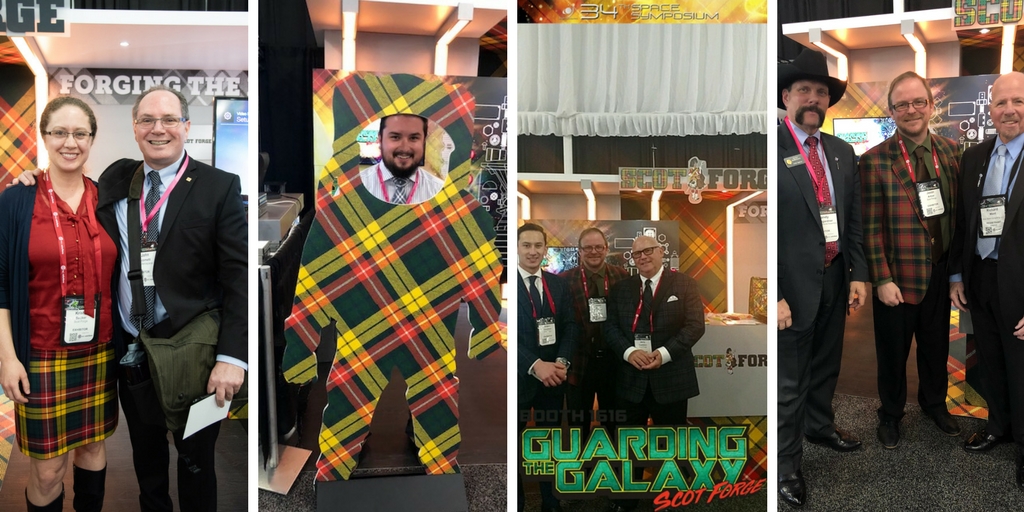5 Hot Topics from the 34th Space Symposium
Scot Forge recently exhibited at the 34th Space Symposium from April 16 - 19, 2018 in Colorado Springs, and boy did we learn a lot! Rather than the experience just benefiting Scot Forge, we want to share what we learned to our customers in the aerospace industry. Here are the top 5 most discussed topics we heard at the show and our takeaways.

Jorgensen Forge Shut Down
It was announced during the Space Symposium that Jorgensen Forge, an open-die and rolled ring forging supplier, will cease operations and close this year for good. For the forging world, this means that a key aerospace supplier has stopped quoting new orders and is telling their customers to start transitioning to competitive suppliers. Jorgensen is well known in the aerospace industry for supplying lighter rolled rings up to 220” OD for Mechanical Ground Support Equipment (MGSE). This news came as quite a shock to Jorgensen’s customers, who were attending the Space Symposium. Nobody likes surprises (unless it’s their birthday… and even then, not all the time). This is especially true of the aerospace market and this news has left several companies in a panic as they struggle to find new suppliers to help in meeting their delivery needs to stay on schedule.
Hypersonics
There was a significant amount of discussion at the Space Symposium about the advancements in hypersonic technology throughout the world, mainly focused on Kinzhal, Russia’s new hypersonic missile. It’s been reported that Kinzhal can travel as fast as Mach 10 over a distance as great as 1,200 miles, all while maneuvering. If this is true, the new Russian missile would be able to tear through the most highly developed US defenses. Additionally, China has claimed they have a hypersonic missile that could reach the US mainland, along with testing a ballistic missile paired with a hypersonic glide vehicle (HGV). France and India have also joined the race to produce similar high-speed weaponry. While none of these nations have perfected their missiles, they are all making advancements to their arsenal. Earlier this year General John Hyten, Commander United States Strategic Command, acknowledged that the US needs new defense technologies to address these increasing global threats, along with continued advancement and testing of our own hypersonic missiles.
Greater Use of Composite Materials & 3D Printing
The use of advanced materials in aircraft is growing as manufacturers strive to improve performance and reduce maintenance requirements and aircraft weight. Composites such as carbon fiber reinforced plastic (CFRP) are increasingly replacing aluminum. Additionally, engine manufacturers are developing ceramic matrix composite (CMC) components, which have a higher heat tolerance than metal alloys, to create more fuel-efficient engines. Additive manufacturing, also known as 3D printing, can produce parts with intricate geometries relatively easily in a variety of materials - including metals, polymers, and composites – and tends to reduce energy use and tooling costs for complex parts. However, Scot Forge still believes composite materials and additive manufacturing are a long way away from competing head-to-head against forged products for aerospace, due to the elimination of porosity, contoured grain flow and fine grain size inherent to the forging process. However, composite materials and 3D printing are currently a real threat to the replacement of castings. As forging companies look to convert critical castings to forgings in the future, we’re sure to meet composite material suppliers and 3D printers on the playing field.
GBSD
In second half of 2017, the US Air Force awarded contracts to Boeing and Northrop Grumman to continue work on their designs for the replacement of the Minuteman III. The new Minuteman III will be the updated, ground-based leg of the nation’s “nuclear triad” strategic deterrent strategy. The week after the Space Symposium, the US launched a successful test fire of the Minuteman III, known as the LGM-30, from Vandenberg Air Force Base.
GPS Satellites Vulnerable to Attack
In early March, Air Force officials announced to Congress that GPS satellites are vulnerable to attack from Chinese and Russian lasers and missiles. These GPS satellites not only guide precision guided weapons, but also our day-to-day car navigation. This launched further discussion at the Space Symposium about the creation of the United States Space Corps, a proposed sixth branch of the United States Armed Forces that would absorb the USAF space warfare mission currently conducted by AF Space Command. Space is quickly becoming its own battleground; the conflict is not fully defined yet, or how it’s going to be fought but we see movement among our customers in regards to the creation and refinement of directed energy weapons, space lasers and other high technology arms as part of military space defense. We anticipate more focus on the creation of jam-resistant GPS’s and satellites that can’t be blinded by lasers from the ground in the near future.